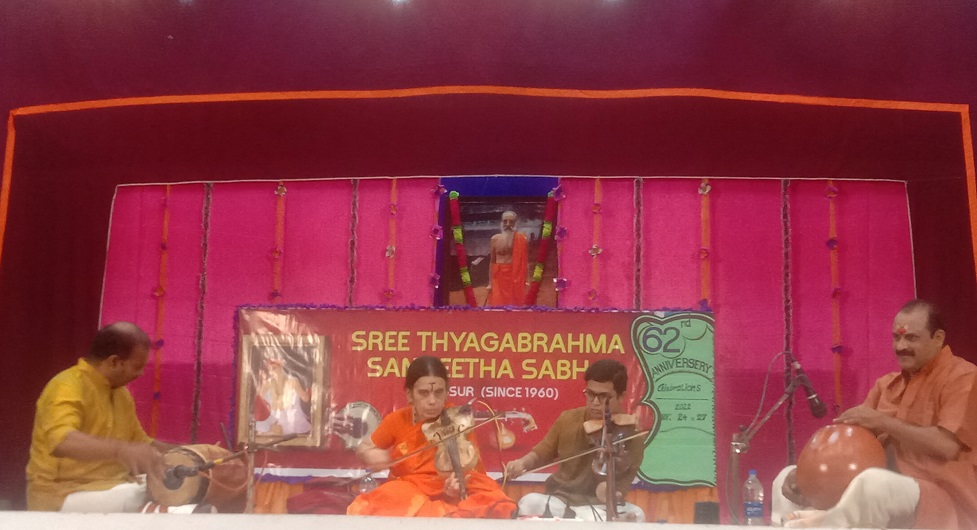The four-day music festival featured both veterans as well as emerging artists.
Swararaga Sudha 2022, a four-day music festival held recently in Thrissur, Kerala marked 62nd-anniversary celebrations by Sree Thyagabrahma Sangeetha Sabha. One of the oldest Sabhas in Kerala, the organisation was inaugurated by the doyen Ariyakudy Ramanujam Iyyenkar in 1960.
The festival was the first in Thrissur during the post-pandemic. For the same reason, the enthusiasm of both the organisers and rasikas was very much evident from the first day itself. A knowledgeable audience was present on the four days.
The festival had an auspicious beginning with a vocal recital by Sivasri Skandaprasad accompanied by Attukal Subramanian on the violin, Sridath S Pillai on the mridangam and Vellattanjoor Srijith on the ghatam. A sloka after, ‘Entharo mahanu bhavulu’ in Sri vouched for her clarity of syllables. Moreover, she appeared in a mood of meditation and the short but familiar composition in Vivardhini raga, ‘Vinave O Mansa’ followed. Todi received an extensive alap for the Muthayya Bhagavar composition ‘Minalochani amba’. ‘Akhilandeswari’ (Dwijavanthi) added to the ambience of contemplation.
The main raga was Kalyani which was essayed to the hilt and the composition was Muthuswami Deeskhitar’s Kamalambam Bhajare. Niraval at ‘Kamalapura’ was enticing. But the tani for the same was unduly prolonged. Notable among other numbers was the ‘Mayamma yanine’ of Syamasastri in Ahiri.
Ramakrishna Moorthy exhibited his musical prowess through select numbers on the second day. Opening with a short alap of Begada, he took ’Lokava chatura’ of Thyagaraja in which swaraprasthara was mesmerizing. ‘Evarini’ (Devanmruthavarshini) and ‘Sankari sankuru’ (Saveri) were presented with élan. Moorthy who had exhibited a penchant for fast tempo switched on to Swati’s ‘Suma sayaka’ in Karnataka Kapi which was slow-paced and soothing.
Once again Kalyani was the main raga. His choice was Dikshitar’s ‘Bhajare chitha’ in Misrachap thalam. On the violin, R K Sreeramkumar aptly followed in the right proportion. Moorthy gave enough scope to Sreekumar and Vijay Natesan (mridangam) to demonstrate their creativity. Niraval swaras presented as a dialogue between the vocalist and mridangam and violin separately was especially noteworthy. Uduppi Sreedhar was on the ghatam.
Poochi Sreenivasa Iyyenkar’s ‘Vada ninne’ in Kapi and rupakam, Swati’s ‘Panimathi mukhi’ in Ahiri and misrachap and a bhajan in Yamunakalyani were the other numbers.
Marvellous performances of senior artists
V R Dileepkumar presented a scholarly concert beginning with the popular ‘Gajavadana’ of Papanasam Sivan in Sreeranjini. The short kirtana in Jayantsree of Thyagaraja, ‘Marugelara’ was the next. Sancharas in mandra sthayi in ‘Sreenivasa tiru Venkata’ in Hamsanandi were alluring but Dileep glided over the three sthayis to make it more endearing.
Post Thyagaraja’s ‘Venu Rama’ in Kedaragoula, Mukhari received a structured treatment which was really commendable. The composition was Subbarayasastri’s ‘Ema ni ne’ in adi. C S Anuroop’s violin was highly innovative. While KMS Mani’s accompaniment was in the right proportion the percussion tani was not noisy but inspiring.
‘Muraleedhara Gopala’ in Mandu,’Rama nama’ in Desh and ‘Karpakame’ in Madhyamavathy were the other numbers that followed.
A three-hour, high-octane violin recital by Kanyakumari marked the festival’s finale. What demarcated her concert was her interaction with the audience that helped to establish a rapport with them right from the very beginning. Around sixteen compositions she bowed out was further a testimony of her proclivity for melody as well as mastery over the instrument. She proved a devotee of Thyagaraja by selecting nearly eight of his choicest compositions including ‘ Rare mayintidaka’ (Asaveri), ‘Jagadanantkaraka’ (natta), ‘Rama nannu brovara’ (Harikamboji), ‘Ninnu vina namadenu’ (Navarasakannada), ‘Evarito ne delpudu’ (Manavati), ‘Ananthudanuganu’ (Jigla) and ‘Intha soukyamanine’.
She explained how Annamacharya had created seven compositions in seven ragas about the seven hills at Tiruppathi. Among them, she chose Seshadri and explained its arohana and avarohana. The composition was ‘Emani thala’.
Kanyakumari asked the audience what raga they want as the main one for the day. The response was mixed. Her ingenuity consisted in taking Kapi as the main one, followed by tana and then a ragamalika that contained all the ragas suggested by the audience including Todi, Bhairavi, Saramati and Sudhasaveri, thereby satisfying all! The percussion tani was literally a fireworks by Nanjil Arul (mridangam) and Mnjoor Unnikrishnan (ghatam).
A slew of light numbers like ‘Krishna ne begane’, ‘Oruneramenkilum’, ‘Om namo Narayana’, Sindhubhairavi tillana, her own composition, ‘Venkitachala nilayam’, ‘Bhagyadalakhshmi’ and a Thirupukazhu viz.’ Muthaithiru’ were played before she concluded to a wild applause from the audience.
Kanyakumari’s performance seemed worthy of emulation by the young musicians since it was both didactic and presented for the audience.
The credit for the systematic conduct of the festival goes mainly to K M S Mani, the secretary and a mridangam artiste as also to the members of the committee.


1 Comment
An insightful review. Excellent.